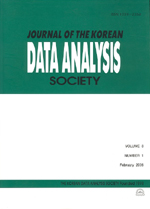중국 위안화의 균형환율에 관한 실증연구
An Empirical Study on Chinese RMB Equilibrium Exhcnage Rate
- 한국자료분석학회
- Journal of The Korean Data Analysis Society (JKDAS)
- Vol.13 No.5
-
2011.102585 - 2598 (14 pages)
- 14

본 연구는 최근 활발하게 논의되고 있는 중국 위안화의 저평가 여부를 평가하기 위해 균형환율 추정을 시도하였다. 추정 방법에 따른 차이를 고려하기 위해 다양한 방법을 시도하였다. 무역수지의 균형을 중시하는 무역균형환율, 장기적으로 경제의 대내외 균형을 동시에 달성하는 기본균형환율(fundamental equilibrium exchange rate), 주요 경제변수들의 동태적 행태를 바탕으로 이들의 균형관계로부터 균형환율을 추정하는 행태균형환율(behavioral equilibrium exchange rate) 등을 추정하였다. 아울러 상태공간(state-space) 모형을 이용하여 위안화 환율의 영구적 요소로부터 균형환율 추정을 시도하였다. 1985년부터 2009년까지의 자료를 이용하여 추정한 결과 무역수지 균형환율과 기본균형환율을 실제 환율과 비교해 보면 위안화는 과소평가되어 있는 것으로 나타났다. 그러나 행태균형환율이나 상태공간 모형에 의한 균형환율 추정치와 비교해 보면 현재의 환율이 균형환율로부터 많이 벗어나 있지 않은 것으로 나타났다. 따라서 중국의 위안화가 과소평가되었다는 주장은 무역불균형 측면만을 고려한 결과라 할 수 있다.
In this paper Chinese renminbi (RMB) equilibrium real exchange rate is estimated and compared with the market exchange rate, and the issue of whether or not to adjust the exchange rate is discussed. Determining how to adjust the exchange rate is of great practical significance to make a balanced judgment so as for the exchange rate system to serve the macroeconomic targets. With data from 1985 to 2009, four different equilibrium exchange rate models are employed : the trade balance equilibrium exchange rate, the fundamental equilibrium exchange rate (FEER), the behavioral equilibrium exchange rate (BEER) and the state-space model. The results of the estimation indicate that different methods bring out different results. The trade balance equilibrium model and the FEER show that the RMB is usually under-valued. However, the BEER and the state-space model suggest the RMB is in slight over-valuation. Therefore we cannot definitely conclude that the RMB is under-valued. The best way of reforming the RMB exchange rate regime is to let the market decide the equilibrium exchange rate through the liberalization of Chinese exchange market.
1. 서론
2. 위안화 균형환율에 관한 선행연구
3. 실증분석 모형의 설정
4. 자료
5. 균형환율 추정결과
6. 결론 및 시사점
참고문헌
(0)
(0)